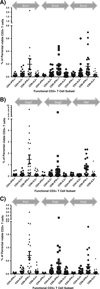Establishment and maintenance of a PBMC repository for functional cellular studies in support of clinical vaccine trials
- PMID: 24787274
- PMCID: PMC4152919
- DOI: 10.1016/j.jim.2014.04.005
Establishment and maintenance of a PBMC repository for functional cellular studies in support of clinical vaccine trials
Abstract
A large repository of cryopreserved peripheral blood mononuclear cells (PBMCs) samples was created to provide laboratories testing the specimens from human immunodeficiency virus-1 (HIV-1) vaccine clinical trials the material for assay development, optimization, and validation. One hundred thirty-one PBMC samples were collected using leukapheresis procedure between 2007 and 2013 by the Comprehensive T cell Vaccine Immune Monitoring Consortium core repository. The donors included 83 human immunodeficiency virus-1 (HIV-1) seronegative and 32 HIV-1 seropositive subjects. The samples were extensively characterized for the ability of T cell subsets to respond to recall viral antigens including cytomegalovirus, Epstein-Barr virus, influenza virus, and HIV-1 using Interferon-gamma (IFN-γ) enzyme linked immunospot (ELISpot) and IFN-γ/interleukin 2 (IL-2) intracellular cytokine staining (ICS) assays. A subset of samples was evaluated over time to determine the integrity of the cryopreserved samples in relation to recovery, viability, and functionality. The principal results of our study demonstrate that viable and functional cells were consistently recovered from the cryopreserved samples. Therefore, we determined that this repository of large size cryopreserved cellular samples constitutes a unique resource for laboratories that are involved in optimization and validation of assays to evaluate T, B, and NK cellular functions in the context of clinical trials.
Keywords: Cryopreservation; Peripheral blood mononuclear cells; Repository.
Copyright © 2014 Elsevier B.V. All rights reserved.
Figures






References
-
- Britten CM, Janetzki S, Butterfield LH, Ferrari G, Gouttefangeas C, Huber C, Kalos M, Levitsky HI, Maecker HT, Melief CJM, O’Donnell-Tormey J, Odunsi K, Old LJ, Ottenhoff THM, Ottensmeier C, Pawelec G, Roederer M, Roep BO, Romero P, van der Burg SH, Walter S, Hoos A, Davis MM. T cell assays and MIATA: The essential minimum for maximum impact. Immunity. 2012;37:1. - PubMed
-
- Cox JH, Ferrari G, Kalams SA, Lopaczynski W, Oden N, D’souza MP Elispot Collaborative Study Group. Results of an ELISPOT proficiency panel conducted in 11 laboratories participating in international human immunodeficiency virus type 1 vaccine trials. AIDS Res. Hum. Retroviruses. 2005;21:68. - PubMed
Publication types
MeSH terms
Substances
Grants and funding
LinkOut - more resources
Full Text Sources
Other Literature Sources
Medical

